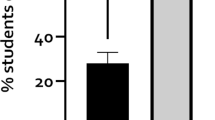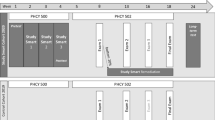Abstract
Background
Despite the existence of data describing student factors and test-taking habits associated with success, preclinical medical students preparing for the USMLE Step 1 exam face the challenges of creating a study plan and selecting between study-aid resources while preparing for this high-stakes test. This is often an expensive and anxiety-provoking experience.
Methods
A near-peer support group for second year medical students studying for the USMLE Step 1 exam at the Albert Einstein College of Medicine (Einstein) provided evidence-based recommendations with goals of facilitating study planning and raising scores. An annual survey evaluating study habits and group perception was collected to identify study habits associated with higher Step 1 scores, evaluate group effectiveness, and refine the evidence-based recommendations for optimal exam preparation.
Results
Over a 3-year period, 302 students responded to the survey. After simultaneous adjustment for factors associated with Step 1 performance in bivariate analyses, preclinical medical school performance (P < 0.01), initiation of study 6 months prior to the test date (P < 0.01), and completion of >4000 practice questions (P = 0.05) remained independently associated with Step 1 scores. There was a significant increase in the average Step 1 score from 226.8 to 230.5 (P = 0.002) after the group began providing evidence-based advice to students. Over 90 % of respondents were aware of the group and 64 % followed the group’s advice. Sixty-seven percent would recommend the group to subsequent students and 79 % found the near-peer format useful.
Conclusions
A student run near-peer support group was a popular and effective mechanism to assist students preparing for the USMLE Step 1 exam by accumulating and disseminating evidence-based study habit recommendations. Certain habits including a start date approximately 6 months in advance and completion of >4000 test-like practice questions may be beneficial in preparing for the Step 1 exam. The increase in average Step 1 score at Einstein may be in part due to this intervention or may represent part of a national trend.
Similar content being viewed by others
References
National Resident Matching Program, Data Release and Research Committee: results of the 2012 NRMP Program Director Survey. Accessed online on March 17, 2014 at http://www.nrmp.org/data/programresultsbyspecialty2012.pdf
Thadani RA, Swanson DB, Galbraith RM. A preliminary analysis of different approaches to preparing for the USMLE step 1. Acad Med. 2000;75(10 suppl):S40–S2.
Kasuya RT, Naguwa GS, Guerrero APS, Hishinuma ES, Lindberg MA, Judd NK. USMLE performances in a predominantly Asian and Pacific islander population of medical students in a problem-based learning curriculum. Acad Med. 2003;78(5):483–90.
Cuddy MM, Swanson DB, Clauser BE. A multilevel analysis of examinee gender and USMLE step 1 performance. Acad Med. 2008;83:S58–62.
Paolo AM, Bonaminio GA, Durham D, Stites SW. Comparison and cross-validation of simple and multiple logistic regression models to predict USMLE step 1 performance. Teach Learn Med. 2004;16:69–73.
Donnon T, Paolucci EO, Violato C. The predictive validity of the MCAT for medical school performance and medical board licensing examinations: a meta-analysis of the published research. Acad Med. 2007;82(1):100–6.
Zhang C, Rauchwarger A, Toth C, O’Connell M. Student USMLE step 1 preparation and performance. Adv Health Sci Educ Theory Pract. 2004;9(4):291–7.
Hu Y, Martindale JR, LeGallo RD, White CB, McGahren ED, Schroen AT Relationships between preclinical course grades and standardized exam performance. Adv Health Sci Educ Theory Pract. 2015. ePub September 2015.
West C, Kurz T, Smith S, Graham L. Are study strategies related to medical licensing exam performance? Int J Med Educ. 2014;5:199–204.
Kumar AD, Shah MK, Maley JH, Evron J, Gyftopoulos A, Miller C. Preparing to take the USMLE step 1: a survey on medical students’ self-reported study habits. Postgrad Med J. 2015;91:257–61.
Werner LS, Bull BS. The effect of three commercial coaching courses on step one USMLE performance. Med Educ. 2003;37:527–31.
McGaghie WC, Downing SM, Kubilius R. What is the impact of commercial test preparation courses on medical examination performance? Teach Learn Med. 2004;16:202–11.
Tompkins J. Money for nothing? The problem of the board-exam coaching industry. N Engl J Med. 2011;365(2):104–5.
Cate OT, Durning S. Peer teaching in medical education: twelve reasons to move from theory to practice. Med Teach. 2007;29:591–9.
Cate OT, Durning S. Dimensions and psychology of peer teaching in medical education. Med Teach. 2007;29:546–52.
Bulte C, Betts A, Garner K, Durning S. Student teaching: views of student near-peer teachers and learners. Med Teach. 2007;29:583–90.
Jackson TA, Evans DJR. Can medical students teach? A near-peer-led teaching program for year 1 students. Adv Physiol Educ. 2012;36:192–6.
Heckmann JG, Dütsch M, Rauch C, Lang C, Weih M, Schwab S. Effects of peer-assisted training during the neurology clerkship: a randomized controlled study. Eur J Neurol. 2008;15(12):1365–70.
Secomb J. A systematic review of peer teaching and learning in clinical education. J Clin Nurs. 2008;17:703–16.
Field M, Burke JM, McAllister D, Lloyd DM. Peer-assisted learning: a novel approach to clinical skills learning for medical students. Med Educ. 2007;41:411–8.
Weyrich P, Celebi N, Schrauth M, Möltner A, Lammerding-Köppel M, Nikendei C. Peer-assisted versus faculty staff-led skills laboratory training: a randomised controlled trial. Med Educ. 2009;43:113–20.
Blank W, Blankenfeld H, Vogelmann R, Linde K, Schneider A. Can near-peer medical students effectively teach a new curriculum in physical examination? BMC Med Educ. 2013;13:165.
Meller SM, Chen M, Chen R, Haeseler FD. Near-peer teaching in a required third-year clerkship. Yale J Biol Med. 2013;86:583–9.
Yu TC, Wilson NC, Singh PP, Lemanu DP, Hawken SJ, Ag H. Medical students-as-teachers: a systematic review of peer-assisted teaching in medical school. Adv Med Educ Pract. 2011;2:157–72.
Wong JG, Waldrep TD, Smith TG. Formal peer teaching in medical school improves academic performance: the MUSC supplemental instructor program. Teach Learn Med. 2007;19:216–20.
Lockspeiser TM, O’Sullivan P, Teherani A, Muller J. Understanding the experience of being taught by peers: the value of social and cognitive congruence. Adv Health Sci Educ. 2008;13:361–72.
Johnson JH, Jordan EJ, Silbinger S. Process and experience of creating a student-run step 1 guidance program. Einstein J Biol Med. 2013;29:52–3.
Alcamo AM, Davids AR, Way DP, Lynn DJ, Vandre DD. The impact of a peer-designed and -led USMLE step 1 review course: improvement in preparation and scores. Acad Med. 2010;85(10 suppl):S45–8.
Strowd RE, Beard HR, Gorney B, Russell GB, Lambros A. The impact of process-oriented preparation on high-stakes testing in medical school. Med Sci Educ. 2013;23(4):588–94.
Peterson CA, Tucker RP. Medical gross anatomy as a predictor of performance on the USMLE step 1. Anat Rec, Part B, New Anatomist. 2005;283(1):5–8.
Vora A, Maltezos N, Alfonzo L, Hernandez N, Calix E, Fernandez MI. Predictors of scoring at least 600 on COMLEX-USA level 1: successful preparation strategies. J Am Osteopath Assoc. 2013;113(2):164–73.
Pohl CA, Robeson MR, Hojat M, Veloski JJ. Sooner or later? USMLE step 1 performance and test administration date at the end of the second year. Acad Med. 2002;77(10 suppl):S17–9.
Wayne SJ, Fortner SA, Kitzes JA, Timm C, Kalishman S. Cause or effect? The relationship between student perception of the medical school learning environment and academic performance on USMLE step 1. Med Teach. 2013;35:376–80.
Mathis BR, Warm EJ, Schauer DP, Holmboe E, Rouan GW. A multiple choice testing program coupled with a year-long elective experience is associated with improved performance on the internal medicine in-training examination. J Gen Intern Med. 2011;26(11):1253–7.
Chang D, Kenel-Pierre S, Basa J, et al. Study habits centered on completing review questions result in quantitatively higher American Board of Surgery In-Training Exam scores. J Surg Educ. 2014;71(6):e127–31.
USMLE Announcements, Change in minimum passing requirements for Step 1. Available at: http://www.usmle.org/announcements/?ContentId=127. Accessed May 1st 2014.
AAMC Applicants and Matriculants Data. Available at: https://www.aamc.org/download/321494/data/factstable17.pdf. Accessed January 30th, 2015.
Acknowledgments
Dedicated to the memory of beloved educator and mentor Dr. Sharon Silbiger.
Author’s Contributions
Eric Tanenbaum, Jacob Johnson, Eric Jordan, Jennifer Cottral, Christopher Tenore, Sharon Silbiger, and Amanda Raff contributed to the design and execution of the study. William Burton helped with survey design and dissemination, and Aileen McGinn performed the statistical analysis.
Author information
Authors and Affiliations
Corresponding author
Ethics declarations
Competing Interests
None.
Ethical Approval
The study was reviewed and deemed exempt by the Montefiore Medical Center institutional review board.
Funding/Support
Monetary support for survey gift card incentives was provided through Associate Chair of Medicine for Undergraduate Medical Education funds.
Rights and permissions
About this article
Cite this article
Tanenbaum, E.J., Johnson, J.H., Jordan, E. et al. An Effective Evidence-Based Student Run Near-Peer Support Group for the USMLE Step 1 Exam. Med.Sci.Educ. 26, 691–699 (2016). https://doi.org/10.1007/s40670-016-0334-8
Published:
Issue Date:
DOI: https://doi.org/10.1007/s40670-016-0334-8




